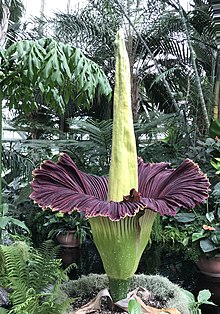Titan arum
| Titan arum | |
|---|---|

| |
| Scientific classification | |
| Kingdom: | Plantae |
| Clade: | Tracheophytes |
| Clade: | Angiosperms |
| Clade: | Monocots |
| Order: | Alismatales |
| Family: | Araceae |
| Genus: | Amorphophallus |
| Species: | A. titanum
|
| Binomial name | |
| Amorphophallus titanum (Becc.) Becc. ex Arcang
| |
| Synonyms | |
| |
The titan arum, Amorphophallus titanum,[1] is a flowering plant with the largest unbranched inflorescence in the world.
The titan arum's inflorescence is not as large as that of the talipot palm, Corypha umbraculifera, but the inflorescence of the talipot palm is branched rather than unbranched.
Due to its odor, which is like the smell of a decomposing animal, the titan arum is called a 'carrion flower', or 'corpse flower', or 'corpse plant'.[2] For the same reason, the name 'corpse flower' is also used for the genus Rafflesia which, like the titan arum, grows in the rainforests of Sumatra. The function of the smell is to attract insect pollinators.[3]
Both male and female flowers grow in the same inflorescence. The female flowers open first, and only lasts (or is "receptive") about 12 to 24 hours. Then a day or two following, the male flowers open. This usually prevents the flower from self-pollinating.
The popular name "titan arum" was invented by the broadcaster and naturalist Sir David Attenborough for his BBC series The Private Life of Plants, in which the flowering and pollination of the plant were filmed for the first time. Attenborough felt that calling the plant Amorphophallus on a popular TV documentary would be inappropriate.[4]
The record size is 3.1 m (10 ft 2.25 in) tall.[5][6]
References[change | change source]
- ↑ from Ancient Greek amorphos, "without form, misshapen" + phallos, "phallus", and titan, "giant"
- ↑ Indonesian: bunga bangkai – bunga means flower, while bangkai can be translated as corpse, cadaver, or carrion.
- ↑ The insects are carrion-eating beetles and flesh flies (family Sarcophagidae).
- ↑ "David Attenborough: a wild life". London: Telegraph. 2008-01-05. Archived from the original on 2014-04-14. Retrieved 2013-02-16.
- ↑ Tallest bloom. Guinness World Records.
- ↑ Koziol, J. 2010. "Corpse flower" makes Guinness record Archived 2020-10-11 at the Wayback Machine. Fosters, September 24, 2010.
